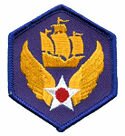-
-
-
-
-

6th Air Force
-
-
-
-
|
|
6th Air Force, Flight D, 1st Rescue Squadron, Waller AFB, Trinidad,
British West Indies
In 1948, Captain Ed Stevens was assigned to Flight D, 1st Rescue Squadron, Waller Air Force Base, Trinidad, British West Indies. Soon after arriving in Trinidad, he was notified that his helicopter had arrived. Stevens went down to the hanger expecting to find a functioning helicopter. Instead, he found a crate that contained the parts of his helicopter. As there was no helicopter mechanic stationed at Waller Field, he recruited some of the base mechanics and he, with their help, put the helicopter together. Ed says the first flight in that helicopter was hair raising event. Since there were no trained helicopter mechanics to assist with the assembly of the helicopter, he wasn't really sure that the helicopter would fly. He says that as exciting as the first flight was, the first return landing was an enormous relief.
In 1948, Ed Stevens made the first landing of a USAF Helicopter on a Navy Carrier, off the coast of Trinidad.
Waller Army Airfield was activated on 1 September 1941. The unit's mission was to establish a flying facility within the United States Army Fort Read post.
The South Atlantic Air Route to Europe quickly developed and became the most often used method of getting aircraft to the African and European theaters of war. Air Transport Command flew aircraft to Waller from South Florida airfields, then from Waller, aircraft were flown to Belem Airfield, Brazil, then across the South Atlantic Ocean to Freetown Airport, Sierra Leone and then to North Africa or England.
With the end of World War II,Waller Airfield was reduced in scope to a skeleton staff. It was redesignated Waller Air Force Base on March 26, 1948. Its primary use was by Military Air Transport Service (MATS) as a transit facility and by the MATS 6th Weather Squadron (Regional), which provided meteorological reports for aviation in the South Caribbean as well as tropical storm and hurricane reporting. President Harry S. Truman stopped at Waller Field on 31 August 1947 on his way to Brazil during a South American visit.
Waller AFB was closed on 28 May 1949 due to budgetary cutbacks and MATS operations were shifted to bases in the Panama Canal Zone.
6th Air Force, USAAF
With the entry of the United States into World War I, concern for the security of the Panama Canal saw the first airborne forces of the Army being sent to the Canal Zone. The first United States air units arrived in the Canal Zone in February 1917, with the 7th Aero Squadron being organized on 29 March. It was equipped with Curtiss JN-4 "Jennys" and Curtiss R-3 and R-4 floatplanes. Plans were made for the establishment of eight aeronautical stations, with a strength of two dirigibles and six or eight seaplanes for observation. The only site identified as immediately usable was at Coco Solo (later called France Field), near Colon. During World War I, the 7th Aero was assigned to patrol for German U-Boats offshore of the Canal Zone under direction of Coast Defenses of Cristobal, from 1 June – 15 November 1918.
A second permanent army airfield, Albrook Field, opened in 1932. A third airfield, Howard Field was built on the Canal Bruja Point Military Reservation, opening on 1 December 1939.
By 1940, a rapid increase in the number of flying squadrons in both the Canal Zone as well as in Panama as a result of the pre–World War II mobilization of the Air Corps warranted a new organization, and the Panama Canal Air Force was created as a major command. After several organizational changes and the establishment of the United States Army Air Forces in 1942, Sixth Air Force became the controlling Air Force command authority for USAAF activities in the Caribbean, as well as in Central and South America. Through all these redesignations it was part of the Caribbean Defense Command, which was the senior United States Army headquarters in the Canal Zone.
Sixth Air Force’s mission was the defense of the Panama Canal and for USAAF relations, including foreign military sales (FMS) and disaster relief assistance, with the Latin American nations. The command supported disaster relief to countries such as Guatemala, Jamaica, Nicaragua, the Dominican Republic, Panama and Colombia. It also assisted nations in Central and South America in purchases of United States military aircraft and trained their technicians in logistics and maintenance for the aircraft
The first wartime mission of the newly created Sixth Air Force was to perform antisubmarine operations in the Caribbean and the Gulf of Mexico areas and to cover Allied shipping convoys in the area.
(For more information on the Sixth Air Force, go to -http://en.wikipedia.org/wiki/United_States_Air_Forces_Southern_Command )
|
|
The post WWII Sixth Air Force, redesignated Caribbean Air Command (1946-63) as part of the 1946 USAAF reorganization, and its successor units returned to its prewar mission, the defense of the Panama Canal; support for friendly Latin American air forces, and to provide support to Latin American nations engaged in anti-communist activities during the Cold War.
The United States Air Forces Southern Command (1963-76) is an inactive Major Command of the United States Air Force. It was headquartered at Albrook Air Force Base, Canal Zone, being inactivated on 1 January 1976.
|
|